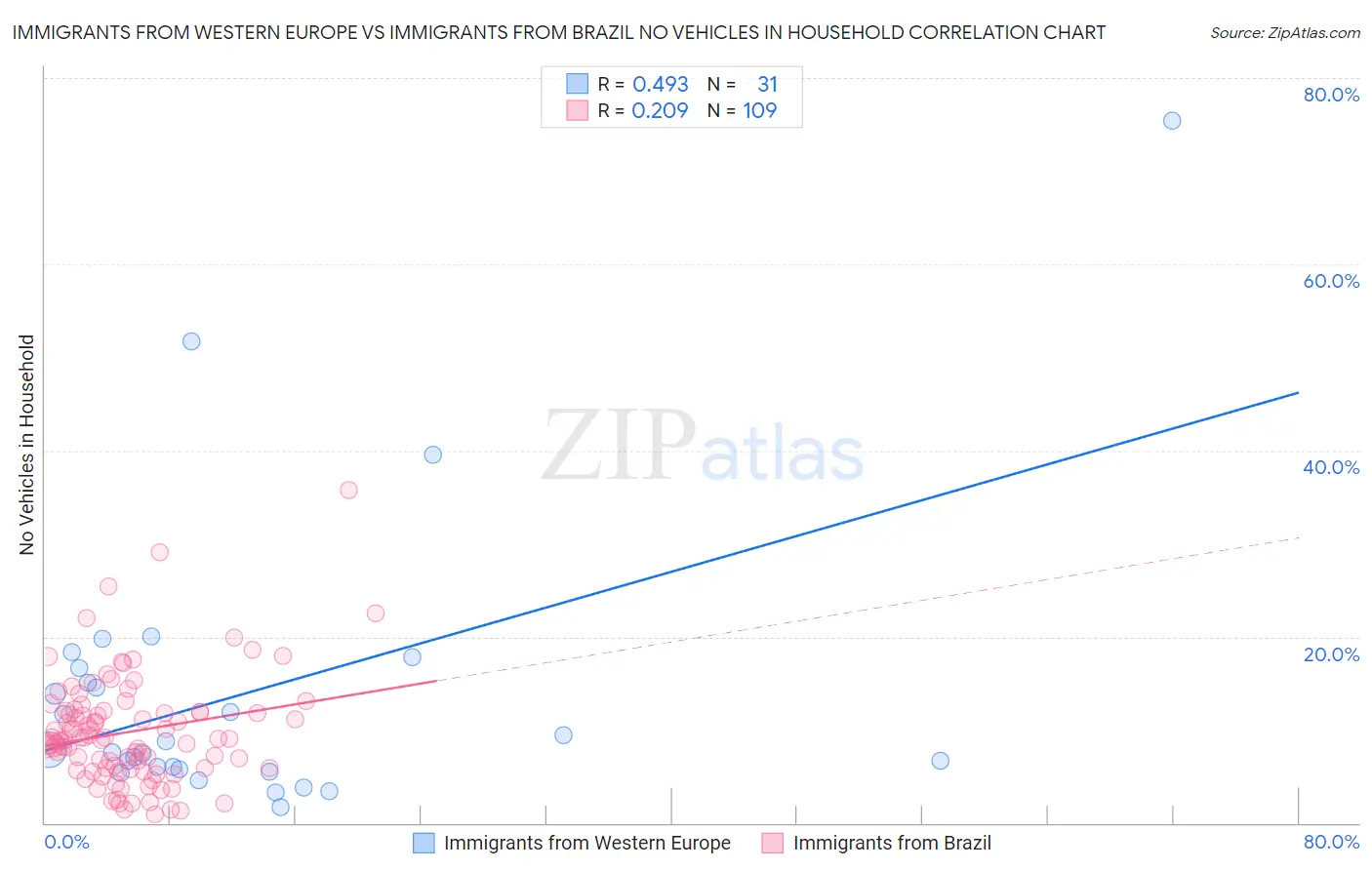Immigrants from Western Europe vs Immigrants from Brazil No Vehicles in Household
COMPARE
Immigrants from Western Europe
Immigrants from Brazil
No Vehicles in Household
No Vehicles in Household Comparison
Immigrants from Western Europe
Immigrants from Brazil
10.9%
NO VEHICLES IN HOUSEHOLD
19.1/ 100
METRIC RATING
201st/ 347
METRIC RANK
10.8%
NO VEHICLES IN HOUSEHOLD
26.3/ 100
METRIC RATING
195th/ 347
METRIC RANK
Immigrants from Western Europe vs Immigrants from Brazil No Vehicles in Household Correlation Chart
The statistical analysis conducted on geographies consisting of 491,986,694 people shows a moderate positive correlation between the proportion of Immigrants from Western Europe and percentage of households with no vehicle available in the United States with a correlation coefficient (R) of 0.493 and weighted average of 10.9%. Similarly, the statistical analysis conducted on geographies consisting of 341,931,543 people shows a weak positive correlation between the proportion of Immigrants from Brazil and percentage of households with no vehicle available in the United States with a correlation coefficient (R) of 0.209 and weighted average of 10.8%, a difference of 1.3%.

No Vehicles in Household Correlation Summary
| Measurement | Immigrants from Western Europe | Immigrants from Brazil |
| Minimum | 1.7% | 0.95% |
| Maximum | 75.4% | 35.7% |
| Range | 73.7% | 34.7% |
| Mean | 14.0% | 9.8% |
| Median | 7.9% | 8.9% |
| Interquartile 25% (IQ1) | 5.8% | 5.9% |
| Interquartile 75% (IQ3) | 16.6% | 12.0% |
| Interquartile Range (IQR) | 10.8% | 6.1% |
| Standard Deviation (Sample) | 15.5% | 5.8% |
| Standard Deviation (Population) | 15.2% | 5.8% |
Demographics Similar to Immigrants from Western Europe and Immigrants from Brazil by No Vehicles in Household
In terms of no vehicles in household, the demographic groups most similar to Immigrants from Western Europe are Cambodian (10.9%, a difference of 0.11%), Romanian (10.9%, a difference of 0.27%), Iroquois (10.9%, a difference of 0.34%), Immigrants from Asia (10.9%, a difference of 0.44%), and Guatemalan (11.0%, a difference of 0.68%). Similarly, the demographic groups most similar to Immigrants from Brazil are Pueblo (10.8%, a difference of 0.11%), Ukrainian (10.7%, a difference of 0.29%), Central American (10.8%, a difference of 0.34%), Shoshone (10.8%, a difference of 0.38%), and Immigrants from Sweden (10.8%, a difference of 0.59%).
| Demographics | Rating | Rank | No Vehicles in Household |
| Immigrants | Armenia | 37.5 /100 | #188 | Fair 10.6% |
| Immigrants | Eritrea | 36.3 /100 | #189 | Fair 10.6% |
| Immigrants | North Macedonia | 34.6 /100 | #190 | Fair 10.6% |
| Immigrants | Northern Europe | 33.1 /100 | #191 | Fair 10.7% |
| Carpatho Rusyns | 32.1 /100 | #192 | Fair 10.7% |
| Ukrainians | 28.0 /100 | #193 | Fair 10.7% |
| Pueblo | 27.0 /100 | #194 | Fair 10.8% |
| Immigrants | Brazil | 26.3 /100 | #195 | Fair 10.8% |
| Central Americans | 24.3 /100 | #196 | Fair 10.8% |
| Shoshone | 24.1 /100 | #197 | Fair 10.8% |
| Immigrants | Sweden | 22.9 /100 | #198 | Fair 10.8% |
| Immigrants | Asia | 21.3 /100 | #199 | Fair 10.9% |
| Cambodians | 19.6 /100 | #200 | Poor 10.9% |
| Immigrants | Western Europe | 19.1 /100 | #201 | Poor 10.9% |
| Romanians | 17.9 /100 | #202 | Poor 10.9% |
| Iroquois | 17.6 /100 | #203 | Poor 10.9% |
| Guatemalans | 16.1 /100 | #204 | Poor 11.0% |
| Immigrants | Chile | 15.9 /100 | #205 | Poor 11.0% |
| Somalis | 15.9 /100 | #206 | Poor 11.0% |
| Sierra Leoneans | 15.7 /100 | #207 | Poor 11.0% |
| Immigrants | Italy | 15.6 /100 | #208 | Poor 11.0% |